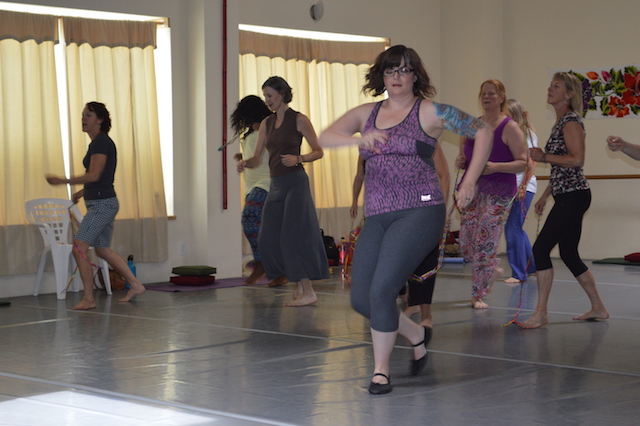Where is this Picture Going to End Up?
Imagine that you are walking into a class for the first time—something that may feel intimidating. Imagine it’s a yoga, dance, Pilates or a martial arts-based self-defense class. You may already be feeling self-conscious about not looking good enough and fearful that you’re not going to be able to measure up in terms of skill.
The first few minutes of the class seem to be going alright, and just as you are coming to terms with your right to belong in the class—click. You hear a camera snap a picture. Your attention is jolted and then you look in another direction, and you see an instructor’s assistant rolling a video on a phone.
“Where is this picture going to end up?”
“Facebook? The Internet? Are they going to be laughing at me too?”
“What if people from work see this? Or worse yet, my ex-partner who has a tendency to follow me wherever I go?”
I often send my clients to yoga, dance or martial arts-based self-defense classes because I fervently believe in embodied healing. It’s challenging enough to find group classes that are sufficiently trauma-informed and welcoming without worrying about the photography and video element.
As a facilitator of dance and trauma-informed yoga within a small business structure, I understand the vital importance of capturing real-time photography from a marketing perspective. We want to share photographs and video of what we do—photos are powerful content elements on social media and our website. They have the power to show our would-be clients that real people can do what we offer.
Photographs and videos have the potential to inspire.

But what’s the fallout? Have we, as teachers and small business owners, considered the potential emotional costs to those being photographed and filmed? Many times we operate under the assumption that because we took the picture, we own the copyright. As long as that photo was taken in a venue where there was no direct expectation of privacy, like a bathroom, a bedroom, then it can be shared, right? Although an attorney may better write about the legal finesse of these matters, the general assumption is that pictures taken by us, as the copyright owner in a public place, can be shared freely.
But, is this the most ethical thing to do, especially if we run a venture committed to mindful, conscious living?
I actively use photographs and videos of my classes and events on social media and on my website. Admittedly, I am no angel when it comes to being perfectly ethical in all of my implementation of photography. In the spirit of being as trauma-informed as possible, I’ve done my best to respect that my attendees may be dancin with the questions I posed earlier.

Knowing that many students are concerned about issues like body image and people knowing where they’re at, I’ve done my best to implement some practices for ethical photography and video recording in classes I’ve facilitated and at events I’ve lead.
1. Let people know that you are taking pictures and/or shooting video:
This principle represents the spirit and essence of informed consent. In my experience, what upsets many people is being jolted into some type of startle response when the cameras appear. Informing the client that photography or videography will be used is the first principle in being wise and ethical with your use of photography, and you can fine-tune this information with the next principle.
2. Give people the option to “opt out” of having their photos shared on social media or online by approaching you privately:
People generally like to know where the photographs or videos will end up. Announce how you plan to use the photos and videos and giving students permission to tell you “no.” This is a practice in human decency to potentially help to strengthen the trust bond between you and your students. If the student tells you they don’t want their picture out there, respect their wish, it’s likely you’ll have other photos you can use from that class.
I facilitate a practice called Dancing Mindfulness. I’ve had three cases in a three year period of trainees being entangled in messy domestic violence and estranged marriage scenarios and their request was simple—I don’t want my ex to know where I’m at and what I’m doing.
3. It’s not enough to make a note about photography or videoing on posters, Facebook invites or your general informed consent:
When I challenged a studio owner on their photography usage policy, they responded with a quick, “It’s on the flyer that we’ll be taking pictures—that’s our informed consent.” Puzzled, I consulted the flyer and it was in very fine print. If I didn’t know what I was looking for, I would never have seen it. Although noting that you will be taking pictures on a poster or Facebook invite is an extra layer of coverage to your informed consent, nothing is as clear as making the announcement in class; several times if possible.
4. Be as discrete as possible in the way you take photographs:
Use common sense and a spirit of mindfulness in how you take the pictures. Be aware of the intrusive noise that a click-click-click of a conventional camera can make, particularly if the class is in a more silent or gentle place. Avoid getting up in someone’s face and personal space for the sake of the picture. Do not let the presence of taking photographs or video disrupt how the person experiences a class. If you are taking pictures or video in a real-time class or workshop (as opposed to setting up a “posed” class for the purpose of pictures, which may be a viable option for you), always respect the integrity of the class over your need to get picture.
5. Always implement use of a photo/video release if you are going to be sharing photos or videos for promotional purposes (in print or online):
Using a media release is a standard ethical practice if you are going to use the photographs or videos for widespread promotions on websites, in brochures or in other wide-reaching platforms. I make it a practice to use a photo/video release whenever I know they may be eligible for use on one of my websites or a featured piece on Facebook to market my programs.
You can obtain a simple media release through a cursory online search and modify it for the needs of your program. If your business reach is large, you may also consider consulting legal expertise on this matter.
~
Author: Dr. Jamie Marich
Image: courtesy of the author, Pixabay
Editor: Ashleigh Hitchcock









Read 0 comments and reply